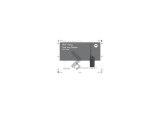
1
CONTENTS
CONTENTS
Contents. . . . . . . . . . . . . . . . . . . . . . . . . . . . .1
Product Safety . . . . . . . . . . . . . . . . . . . . . . . .3
Introduction . . . . . . . . . . . . . . . . . . . . . . . . . .4
Package Contents . . . . . . . . . . . . . . . . . . . . . .4
FCC Licensing Information . . . . . . . . . . . . .6
Batteries and Chargers Safety
Information. . . . . . . . . . . . . . . . . . . . . . . . . . .7
Operational Safety Guidelines. . . . . . . . . . . . .8
Radio Overview . . . . . . . . . . . . . . . . . . . . . . .9
Parts Of The Radio . . . . . . . . . . . . . . . . . . . . .9
Power Button . . . . . . . . . . . . . . . . . . . . .10
Programmable Top Button . . . . . . . . . . .10
Volume Control (+/-) Button . . . . . . . . . .10
Audio Accessory Connector . . . . . . . . . .10
Microphone . . . . . . . . . . . . . . . . . . . . . . .10
Antenna. . . . . . . . . . . . . . . . . . . . . . . . . .10
Tx/Rx Indicator LED . . . . . . . . . . . . . . . .10
Push-to-Talk (PTT) Button . . . . . . . . . . .10
Menu Button . . . . . . . . . . . . . . . . . . . . . .10
The Lithium-Ion (Li-Ion) Battery . . . . . . .10
Battery Features . . . . . . . . . . . . . . . . . . . . . .12
About the Li-Ion Battery . . . . . . . . . . . . . 12
Battery Recycling and Disposal . . . . . . . 13
Installing the Lithium-Ion
(Li-Ion) Battery . . . . . . . . . . . . . . . . . . 14
Removing the Lithium-Ion
(Li-Ion) Battery . . . . . . . . . . . . . . . . . . 15
Holster . . . . . . . . . . . . . . . . . . . . . . . . . . 16
Power Supply, Adaptor and Drop-in
Tray Charger . . . . . . . . . . . . . . . . . . . 16
Battery Life Information . . . . . . . . . . . . . 17
Charging the Battery . . . . . . . . . . . . . . . 18
Drop-in Tray Charger Charge
Status Indicators . . . . . . . . . . . . . . . . 20
Drop-in Tray Charger Battery State of
Charge Indications . . . . . . . . . . . . . . . 21
Estimated Charging Time . . . . . . . . . . . 22
Multi-Unit Charger Charge Status
Indicators . . . . . . . . . . . . . . . . . . . . . . 24
Multi-Unit Charger Battery State
of Charge Indications . . . . . . . . . . . . . 25
Getting Started . . . . . . . . . . . . . . . . . . . . . . 27
Turning radio ON/OFF . . . . . . . . . . . . . . . . . 27
Adjusting Volume . . . . . . . . . . . . . . . . . . . . . 27





















